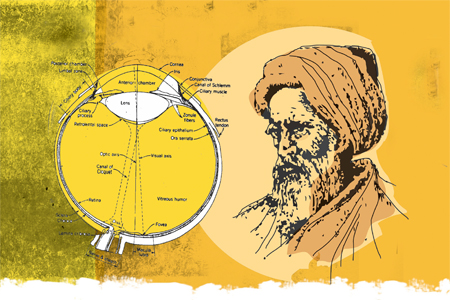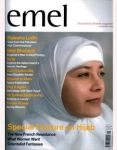
Inspired by Islam- Optical Illusions
Issue 4 Mar / Apr 2004
Light is a fundamental player in our lives and it is hardly surprising that optics as a physical phenomenon has been studied and inquired about by all the great knowledge cultures, most noticeably Islam. Fuad Ali explores the value of scientific explanation of optics which mediate our ability to see each other and our surroundings, to grow food and be the cyber enthusiasts that we are today.
Scientists often build mental pictures and tools in order to explain or predict observations. These theories of physical reality, for all their occasional genius, utility and beauty are ultimately transitory and subject to improvement or overhaul. Theories occasionally run into problems explaining physical effects and run into contradictions, which limit the usefulness of the science. One such controversy was the problem of vision. From the time of Aristotle there were two contradictory theories about how we were able to see objects. The ideas were: that light radiated from the eye toward the object seen and that seeing came about from entry into the eye of an intermediary entity from the object. Both could not be equally true, but both were found to explain certain effects.
The answer might seem basic and intuitive to us today, but the method and reasons backing the scholars’ stance reflect their motivation and values, which in turn can be understood in the framework of Islam. In Kitab al Manazir, Ibn al Haytham resolves this issue through the 'intermediary entity' which has become the photon of modern science. He attributed the confusion to imperfect human senses and inadequate observed evidence. He gave great importance to the scrutiny of fundamental principles and premises, and stated that his intention is that, ‘all we induct and inspect being the application of truthfulness and not the pursuit of whims.’
The optical sciences were nurtured, developed and utilised during the era in which the Islamic knowledge culture led the world. Basra-born Ibn al Haythem’s career emerged within a context of significant Muslim scientific discovery and the abundance of translated Greek science; providing him with a wealth of potential knowledge to explore. He migrated to Cairo at the behest of the ruler there, who was interested in developing Al Haythem’s ideas to build an apparatus to regulate the flow of the great river Nile.
It was not in this branch of engineering, however, that Ibn al Haythem made his greatest contribution. It was in the field of optics that he brought a level of experimental rigour that surpassed both his contemporaries and those before him. He determined virtually everything that Newton advanced regarding optics centuries later and is widely regarded as the founder of optics, having studied the structure of the eye, and explained for the first time why the sun and the moon appear larger on the horizon. Very simply put, it is because the thicker layer of atmosphere at the horizon acts as magnifying lens compared to overhead.
Al-Haytham became the most quoted physicist of the Middle Ages. His works were consulted by a greater number of European scholars during the 16th and 17th centuries; more than those of Newton and Galileo combined. His research was continued two centuries later by Qutb al-Din al-Shirazi and Kamal al-Din al-Farisi. It was Qutb al-Din who gave the first correct explanation of the formation of the rainbow. Scientists of the European knowledge revival accessed works on optics through Latin translations of Arabic texts. Robert Bacon, Kepler, Snell and Fermat had directly referred to and were influenced by Ibn Al –Haythems work.
words: Fuad Ali
illustration: Ruh Al Alam
Fuad Ali is a member of the International Muslim Association of Scientists and Engineers (IMASE) www.imase.org
Bookmark this |
|
Add to DIGG |
|
Add to del.icio.us |
|
Stumble this |
|
Share on Facebook |
|
Share this |
|
Send to a Friend |
|
Link to this |
|
Printer Friendly |
|
Print in plain text |
|


Comments
0 Comments